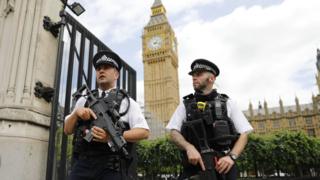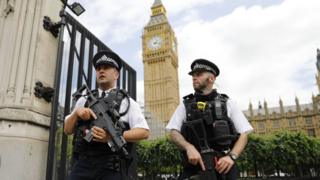Parliament: Are threats to MPs widespread?
Amid concern about a “toxic” atmosphere in Westminster, BBC Reality Check looks at the level of threats MPs face. …

 Image copyright Getty Images
Image copyright Getty Images As MPs clashed in the Commons over Brexit, in an atmosphere described as “toxic” by the Speaker, John Bercow, a number revealed they had received personal abuse, including death threats.
All seven who said they had been targeted in this way were women.
Liberal Democrat leader Jo Swinson said she’d had to report threats to her child to the police.
Paula Sherriff and Jess Phillips, both Labour MPs, described receiving death threats.
How common is abuse?
Run by the Metropolitan Police, the Parliamentary Liaison and Investigation Team (PLAIT) acts as a national body to advise individual police forces on dealing with threats to politicians. It was set up in 2016, following the murder of the MP Jo Cox.
Its data shows in the year ending August 2017, MPs reported 111 crimes targeting them.
This increased to 242 the following year.
Between September 2018 and July 22nd 2019, there have been 238.
It is likely growing awareness of this body has contributed to these rises.
The Met has previously said just 10 MPs have accounted for 29% of the crime reports.
It also said a disproportionate number of those being targeted were women or from ethnic minorities.
Liberal Democrat MP Luciana Berger said six people had already been convicted for targeting her.
Previous data released by the Met Police suggests most of these crimes involve harassment, malicious communications, criminal damage or theft.
Speaking to a select committee in May, Metropolitan Police Assistant Commissioner Neil Basu said Brexit divisions were linked to the rise.
“Brexit has been a huge driver of some of this, post-referendum,” he said.
“We see a relatively even split between people who have been targeted because they are pro‑Brexit and people who have been targeted because they are pro‑Remain.”
He added the reported crimes had been increasing in the first part of this year.
What protections are in place?
The Metropolitan Police chief, Cressida Dick, has said on an average day, about 60 officers are “engaged in nothing but thinking about the protests in the immediate environment of Parliament”.
And in the past, it has been recommended that “on occasion” MPs take taxis when leaving the parliamentary estate.
The Independent Parliamentary Standards Authority also offers security packages, which allow them to purchase security items such as CCTV for their offices or personal alarms.
An Institute for Government report shows between 2016 and 2018, spending on security for individual MPs increased from £171,000 to over £4m.
The government says plans are in place to make it an electoral offence to intimidate candidates and campaigners in the run up to an election.
Additionally, addresses of candidates standing in local or mayoral elections have been removed from ballot papers.
What about language?
It’s been suggested by a number of MPs in the Commons “inflammatory language” could lead to threats and violence.
Jess Phillips, for example, told of a death threat that directly quoted the words of Prime Minister Boris Johnson.
Paula Sherriff, meanwhile, said many MPs were “subject to death threats and abuse every single day” and they often quoted words including “surrender act, betrayal, traitor”.
Mr Johnson used the term “surrender act” 15 times during Wednesday’s debate.
And on Thursday, Labour’s Harriet Harman said guidance on what constituted “unparliamentary language” was outdated.
Parliament’s website lists examples of words that might be considered offensive, including “stoolpigeon”, “blackguard”, “coward”, “git”, “guttersnipe”, “hooligan” and “rat”.
It is largely at the discretion of the Speaker to decide when something meets this bar – John Bercow has recently objected to various “unparliamentary” words, including “idiot” and “bastards”.




